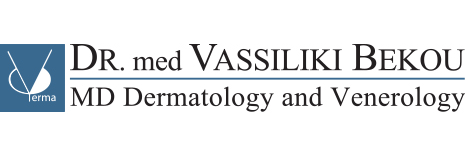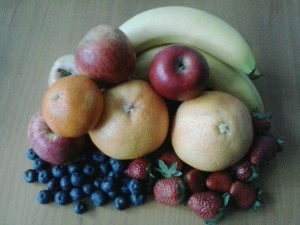( For the texts and pictures books, publications, guidelines for example in awmf.org and contributions of colleagues were consulted.)
According to the recommendations and guidelines of the DGE:
Fibers-Vitamins-Selen
Dietary fibers
Fiber prolong the feeling of satiety and affect carbohydrate metabolism such as by reducing fasting and postprandial blood glucose concentrations. Through enhanced binding and excretion of bile acids dietary fiber can reduce cholesterol concentration and the risk for coronary heart disease. Due to its water -binding capacity, they increase the viscosity of the chyme and stool weight. Thus, dysfunction of the gut, such as constipation, can be prevented with dietary fiber.
During the day the amount of the dietary fibers should be about 30g.
The easiest way to increase the fiber intake by copious consumption of vegetables and fruit, and whole grain products. Carrots, peppers, beetroot, cabbage and fennel contain between 2 and 5 g of fibers per 100g. Even more fibers supply legumes with an average of about 7g per 100g. Tomatoes, zucchini or cucumber, however, have a high water content and only low fiber contents between 0.5 and 1g per 100g. In addition to vegetable salads make vegetable soups or stews another great way to a high-fiber meal.
Berries are among the most fiber-rich fruit species, but they are as fresh fruits only a relatively short season. Four slices of whole wheat bread contain 15g of fiber, the same amount is in about seven slices of whole grain toast, 20 slices of toast or croissants 15. In addition, four slices of wholemeal bread supply just under 340kcal and 1.7g fat, 15 croissants however, 3,050 kcal and 200 g fat.
Vitamins
Vit A
The most valuable contribution to health supplies vitamin A by its importance in building the linings of the mouth, lung and nasopharyngeal space as well as in the defense against infectious diseases and in embryogenesis.
The body can meet its daily requirement of 1 mg of vitamin A in two ways:
by vitamin A- containing foods such as red meat, especially liver, and other animal products such as butter, cheese, eggs and fatty fish or by β -carotene, a pro-vitamin, which can convert itself into vitamin A of the body. Among the foods high in β -carotene content are yellow and dark green vegetables such as broccoli, spinach and green cabbage, but especially carrot, as long as they are eaten cooked or pressed into juice. β -carotene of the carrots is is for the body accessible, by the mechanical pulping in the preparation, and can be metabolized. The antioxidant activity of carotenoids and their biochemical property of influencing the signal values in the cell, will be discussed as the basic mechanisms of the disease- preventive effect.
For the acute effects of UV radiation (sunburn), a protective effect demonstrated by oral administration of β -carotene, which can dependend of dose and duration of administration to achieve a moderate sun protection factor of 4.
In some studies showed an increased risk of lung cancer in high-risk groups smokers and persons with exposure to asbestos at higher doses of β-carotene supplementation. This was attributed to pro-oxidant effects.
Vit C Ascorbic acid
Ascorbic acid is mainly used as an antioxidant use. Many food products it is added as a preservative. In food, vitamin C is found mainly in fruits and vegetables, but its content decreases during cooking, drying or soaking as well as during storage. Citrus fruits like oranges, lemons and grapefruits contain – when ripe immediately after harvest lots of vitamin C. Green cabbage has the highest vitamin C content of all types of cabbage ( 105-120mg/100g edible substance). Red cabbage, white cabbage and sour cabbage are also vitamin C suppliers. The highest natural vitamin C concentrations were found in the bush plum and camu camu.
Vit D
The body needs vitamin D for the construction and maintenance of bone: It regulates calcium and phosphate metabolism and ensures sufficient mineralization and hardening of the bones.
Humans can make vitamin D through sun exposure itself. The body needs vitamin D for the construction and maintenance of bone: It regulates calcium and phosphate metabolism and ensures sufficient mineralization and hardening of the bones.
Depending on the season, for adults its enough, as a rule of the thumb, to expose themselves to the sun for about 5 to 25 minutes per day with uncovered face, hands and parts of the arms and legs. The vitamin D status is assessed in terms of 25-hydroxyvitamin D serum concentration. Estimate of an adequate supply available for children, adolescents and adults is approximately 20 micrograms of vitamin D per day, but only if no endogenous formation takes place.
How much vitamin D is contained in food?
There are few foods, mostly of animal origin that contain vitamin D in significant amounts. These include in particular fatty fish (eg salmon, herring, mackerel) and to a much lesser extent liver, margarine (fortified with vitamin D), egg yolk and some mushrooms. About the diet with the usual foods we carry only about 2 to 4 micrograms of vitamin D per day.
What can consumers do?
Consumers should often go to fresh air both in summer and in winter. Physical exercise and outdoor activity and sports to strengthen muscles and bones. It is recommended to consume one to two times per week oily fish, which also contains n-3 fatty acids and iodine in addition to vitamin D. If there is sufficient residence outdoors and appropriate sun exposure as well as a balanced diet, a good vitamin D supply without taking vitamin D supplements can be achieved.
Vit E Tocopherol
Vitamin E is a collective term for fat-soluble substances with antioxidant and non-antioxidant effects. The most common vitamin E forms are called tocopherols and tocotrienols (derived from the Ancient Greek words τόκος / Tokoš, “birth” and φέρειν / pherein , “to carry”, “bring”). One of its main features is that of a lipid-soluble antioxidant that is able to repeatedly protect unsaturated fatty acids in membrane lipids, lipoproteins and fat depot from destruction by oxidation (lipid peroxidation). Free radicals would attack the double bonds of the fatty acids of the cell and organelle membranes.
Very high levels of vitamin E have vegetable oils such as wheat germ oil (up to 2435 mg/kg of all tocopherol with 70% α-tocopherol), sunflower oil (from 454 to 810 mg/kg of all tocopherol with 86-99 % α-tocopherol), red palm oil (800 mg/kg of total vitamin e, α-tocopherol of 152 and 600 mg/kg tocotrienols) and olive oil (46 to 224 mg/kg of all tocopherol with 89-100% α-tocopherol) on. The dose-and matrix-dependent absorption rate is an average of 30%.
Vitamin E is also synthesized as a racemic mixture. Synthetic tocopherol is relatively unstable and is therefore usually also provided with an acetyl group. This does not have antioxidant properties. However, it can be converted to natural vitamin E in the body to the extent of up to 50 %.
The minimum requirement is 4 mg/day plus about 0.4 mg per gram of feed of polyunsaturated fatty acids. In order to achieve the different, from authors considered protective plasma level, a supply of 20 to 35 mg/d is required.
Selenium
Selenium is an important component of the antioxidant system of humans. The body is thereby protected from the oxidative damage caused by endogenous and exogenous peroxide.
At low selenium plasma concentrations, occur, due to an increased accumulation of lipid peroxides, a disturbance of the formation of prostacycline and an increase in the formation of the vasoconstrictive thromboxane. The consequences are an increased platelet aggregation and an increase in blood pressure. The recommended reasonable daily selenium intake is about 30-70 mcg for adolescents after the age of 15 years and adults.

